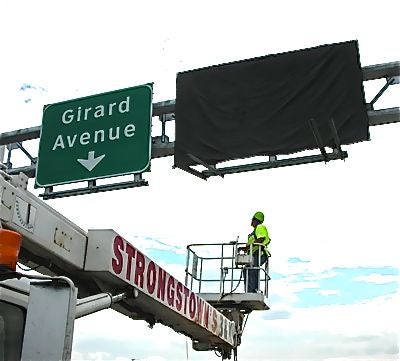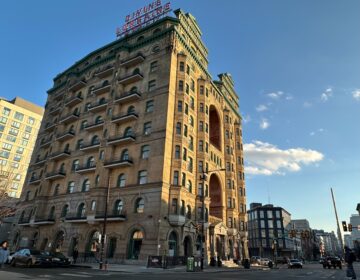PennDOT meets to discuss how trees, lighting, crosswalks can complement I-95 plans

The Pennsylvania Department of Transportation has been meeting with representatives from neighborhoods and organizations along the I-95 corridor from Vine Street to Allegheny Avenue to find out what long-range plans these groups have for their neighborhoods and how PennDOT can help accomplish those goals – or at least not do anything to thwart them – while rebuilding I-95.
Called the Sustainable Action Committee, the group will tonight begin a two-part design charrette that will focus mostly on bridge paint colors, wall finishes, trees and plants and streetscape (items such as sidewalks, bike lanes and lighting) for the early segments of the Girard Avenue project, known as GR1 and GR2. GR0. It should be noted that the creation of a temporary Girard Avenue off ramp, has already been completed. After the second session on Thursday, PennDOT Project Manager Elaine Elbich expects to have specific options in hand.
In addition to leaders from individual neighborhoods, the Sustainable Action Committee also includes representatives from the city’s streets and planning departments, the Delaware River Waterfront Corporation and the Central Delaware Advocacy Group, so that multi-neighborhood plans, such as the in-the-works Master Plan for the Central Delaware, are also considered as PennDOT plans its work.
All of the information the Sustainable Action Committee provides will be given to the design review consultant for which PennDOT recently issued an RFP, Elbich said.
But most of the project design work for GR1 – the phase that includes all major utility work and most of the surface street improvements and relocations, including work on Delaware Avenue, Richmond Street, Aramingo Avenue and Girard Avenue – was completed before the Sustainable Action Committee was created.
Input was sought in other ways, Elbich said. PennDOT met with groups such as the Friends of Penn Treaty Park and the Pennsylvania Environmental Council individually, she said.
For example, “We’re already doing a pedestrian island in Delaware Avenue with a crosswalk” to allow for easier, safer access to Penn Treaty Park,” Elbich said.
The creation of the Sustainable Action Committee streamlines the process of getting direction from the community, Elbich said.
Sarah Thorp, who is managing the Central Delaware Master Plan for the DRWC, is pleased that PennDOT has established the committee, but she laments what she considers some missed opportunities. Take the realignment of Richmond Street, Thorp said. “They are putting bike lanes in the road, which is good. But the curb lines are already set, and there is no way to combine two, single-direction bike lanes into one big lane,” which is what is envisioned for the master plan.
This is mostly a timing issue, Thorp said. DRWC, which came into existance in January 2009, wasn’t around for the early planning stages. And even if PennDOT had talked to DRWC sooner, those working on the master plan “weren’t far enough along in the process to see where the bike lanes should go” when PennDOT was working on the design for GR1. Elbich said PennDOT sought guidance from the Pennsylvania Environmental Council on the bike lanes, as part of the East Coast Greenway trail that will eventually flow from Maine to Florida, and was told that having a single-direction lane on each side of the roadway was just fine.
Elbich said there could be multiple paths in some areas. PennDOT has not yet determined how the old Richmond Street area will be used once the roadway is moved, she said, so there might be a way to create a broader, two-direction path in that area. It is unlikely, however, that such a path could be located on the river-side of the old roadway, she said.
It is anticipated that through future design charrettes or during their more typical meetings, the Sustainable Action Committee will have greater impact on later phases of the Girard Avenue project, where design work is far from complete.
None of the SAC’s meetings are open to the public. “I don’t think we need another public meeting with 200 or 300 people,” Elbich said. That would make this detailed work very difficult, she said. But in the fall, she said, PennDOT will hold public meetings to report on progress and get comments and feedback in each neighborhood, she said.
PennDOT will also be posting results on the Revive 95 website, she said, and they are pondering ways to make that a more interactive experience, where the public can submit comments on different design proposals. In the meanwhile, anyone who lives in the project area and wishes to provide input should contact their community organization to find out who their representative on the SAC is, and give their input through that person, Elbich said.
Judging by comments made at two recent public input meetings on the Central Delaware Master Plan, many Philadelphians would like to see Thorp lobby for portions of I-95 to be rebuilt in an entirely new way – underground or with selective portions capped, for example.
But that option is not on the table, Elbich said. “It’s still out there because of the PennPraxis proposal, but from the feasibility and cost perspective, it’s not being pursued,” she said. “It’s not practical nor affordable.”
There are other parts of the design that the SAC can’t influence. The location of the roadway needs to match up properly with the city street grid, for example.
But for most phases of the project, the SAC can have some say about the support structures that hold up the roadway. Engineering will determine the loads they must hold, Elbich said. But it may be possible to support the same load with more, smaller supports, or fewer, larger ones.
Elbich said one important part of the committee’s work will be determining where pedestrian crossings and pathways are needed.
There may be situations where PennDOT’s budget will cover a certain type or size of tree or style of lighting, and the community wants to upgrade, Elbich said. This would likely mean a partnership arrangement where a community group or organization would pay the extra cost to get what they want. The partnership, which would be spelled out in a memorandum of understanding between PennDOT and the entity that wants the upgrade, would also address particulars such as who is responsible for maintenance.
Reach the reporter at kgates@planphilly.com
WHYY is your source for fact-based, in-depth journalism and information. As a nonprofit organization, we rely on financial support from readers like you. Please give today.






